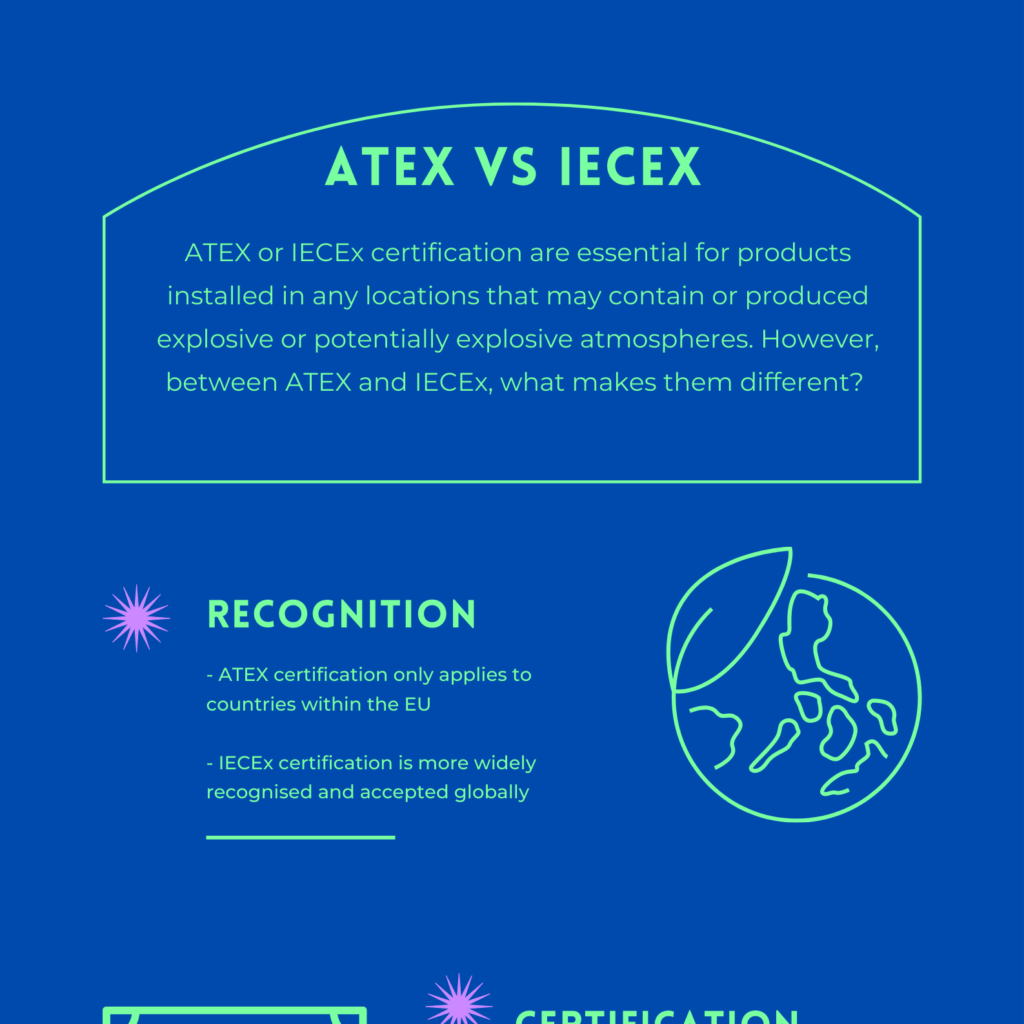ATEX VS IECEx
ATEX or IECEx certification are essential for products installed in any locations that may contain or produced explosive or potentially explosive atmospheres. However, between ATEX and IECEx, what makes them different?
Whenever handling flammable or explosive materials, whether or not it’s gas, vapour, or dust, there’s often a risk of the creation of an explosive atmosphere and environment, and with it, the chance of an explosion in a workplace that would cause serious injuries and devastating damage to equipment will arise.
Regulations, like ATEX and IECEx, exist for this purpose. They cover the requirements and safety measures or practices necessary to be implemented in places and processes where potentially explosive atmospheres can arise.
What is ATEX
The name ATEX comes from the French word “ATmosphère EXplosibles”, describing the equipment and use of a product located in an explosive atmosphere. It comprises of 2 Directives that are established to guard employees from explosion risks: ATEX 95 and ATEX 137.
What is IECEx
IECEx stands for International Electrotechnical Commission Explosive. IECEx is a global certification that’s accepted in all countries to help build confidence in the safety of Explosion Proof equipment.
ATEX vs IECEx
The main difference between ATEX and IECEx is that ATEX certification only applies for countries within the EU while IECEx certification is accepted globally. Hence, the IECEx certification is more widely recognised and accepted compared to ATEX certification.
Another way that IECEx differs from ATEX is that the way each certification is set up. The IECEx certification consists of 4 schemes in total: IECEx Equipment Scheme, IECEx Conformity Mark License, IECEx Services Scheme, and IECEx Certified Persons Scheme.
These four schemes make sure that every aspect of the products conforms to the IECEx standard, from the quality of the explosion proof equipment itself to the competency of the personnel who will be handling such equipment in hazardous environments. ATEX on the other hand, consist of 2 directives, ATEX 95 and ATEX 137.
ATEX 95 applies to electrical or mechanical equipment and any protective systems that may be put in place. Manufacturers of explosion proof equipment must make sure that products undergo appropriate procedures that usually involves approval by an outside agency. ATEX 137 is known as the Workplace Directive and is mainly for improving the health and safety protection of workers at risk from an explosive atmosphere.
Furthermore, ATEX certification can be based on an IECEx test report, but an ATEX documentation might not necessarily support an IECEx certificate. Therefore, it has become a common industry requirement for products to contain both ATEX and IECEx certificates.
Conclusion
International Metal Engineering offers an extensive range of explosion proof equipment that carry both ATEX certification and IECEx certification. For more information, about our explosion proof products that is ATEX and IECEx certified, please go to our Contact Page to send in an enquiry, or drop us a call at +65 6353 6506 to find out more about the explosion proof products we have available.

